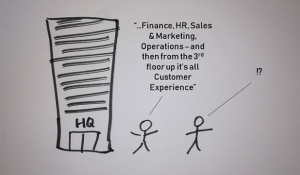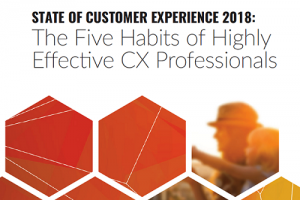Could the 22% of CX Professional Leaders please stand up?

There are some fascinating numbers in the State of Customer Experience 2018: The Five Habits of Highly Effective CX Professionals, produced by Engage (www.engagecustomer.com) and Confirmit (www.engagecustomer.com) – and lots else, it’s a really useful document, full of great insight, research and ideas. However, I’m somehow unconvinced by its categorisation of 22% of “CX professionals” as Leaders.
Why?
Let me explain.
Firstly, I have a bit of a problem with the ‘professionalisation’ of customer experience. Of course there are particular tools, techniques and insights which are vital to improving customer experience, but fundamentally listening to customers doesn’t require the reserved membership or the equivalent of a medieval Guild. Practically anyone can do it and everyone in the organisation should be encouraged to contribute. Some of the best insights will be from the employees who spend all day dealing with customers in the field, on the shop-floor and in the contact centre.
Secondly, the ‘Leader’ category described in the State of Customer Experience 2018 is restricted to those respondents who could see “significant increase in budget in the next 12 months (9 or 10 on a 0-10 scale)”. Sorry, but I just don’t buy this! I’m not naive and I understand that in modern, complex organisations investment in the right techniques and technologies are needed as well as a – simple sounding; hard to achieve – willingness to try and understand what the customer wants. But empire and budget-building are no guarantee of anything. Surely better an unfunded and authentic customer orientation than a vast programme of journey mapping, C-SAT, CES, CX and NPS scoring that goes nowhere (and we’ve all seen just those sort of programmes in action)?
Fundamentally, achieving a great customer experience is very hard work for a variety of reasons. Although being given a bigger budget might be a great help (and presumably at least shows you’ve got some of the necessary support from the Board level) of itself it won’t achieve a thing – except make your search for those elusive sources of evidence of the (undoubted) relationship between customer experience and business performance even more urgent!
So, if – despite my reservations – you aspire to be a leading “CX Professional” but have little or no budget, then don’t despair! Here’s a list of 7 things you can do with no budget, except maybe the cost of a few train fares:
1. Set out on a road trip and talk to colleagues (and your suppliers’ and business partners’ employees) who are in contact with customers
2. Go online and take some customer journeys – make some calls, start a chat, follow the Contact Us directions and see what happens
3. Identify some real customers (at random or on the basis of feedback or complaints), make contact, tell them what you’re doing and ask to talk to them
4. Go the contact centre and listen to calls, read emails and chats and write some notes
5. Find out what groups within your organisation are developing new propositions, contact channels, offers and find out if they have a ‘customer representative’ on board. If they haven’t, find one. Quick!
6. Make a first draft of your CX priorities and changes
7. And be prepared to adjust it as you go – your organisation isn’t static and neither are your customers




